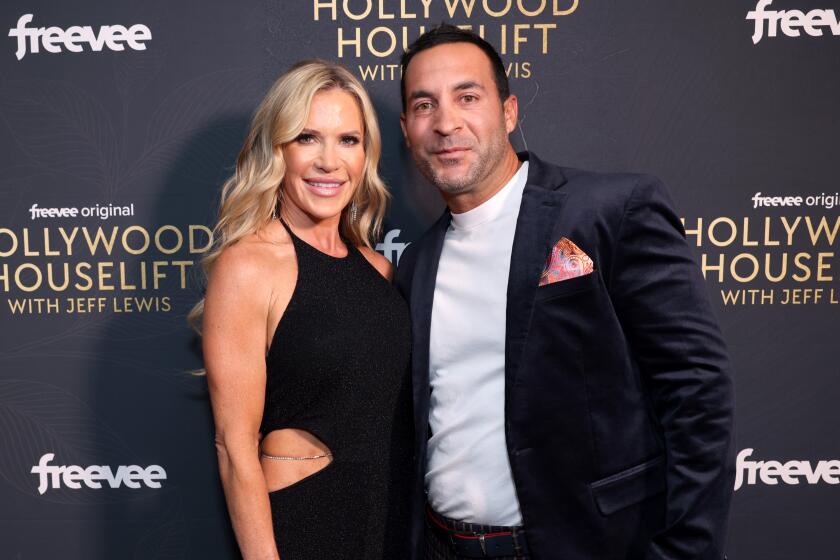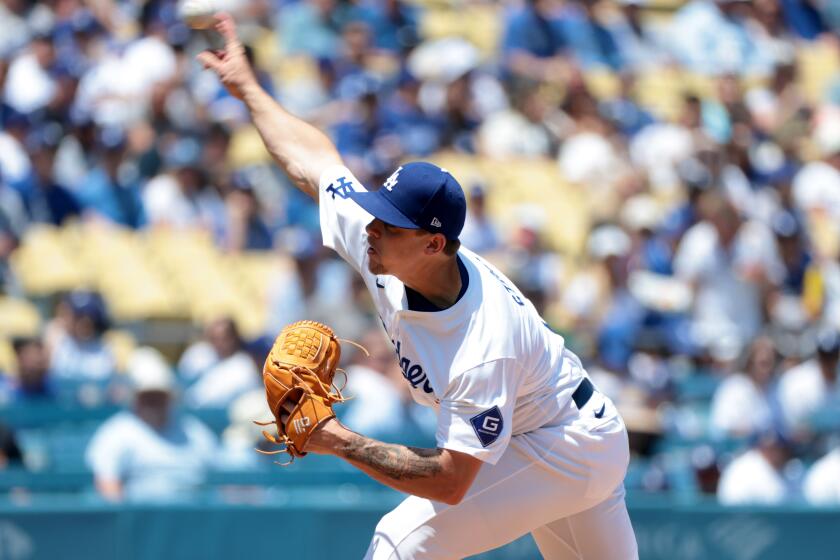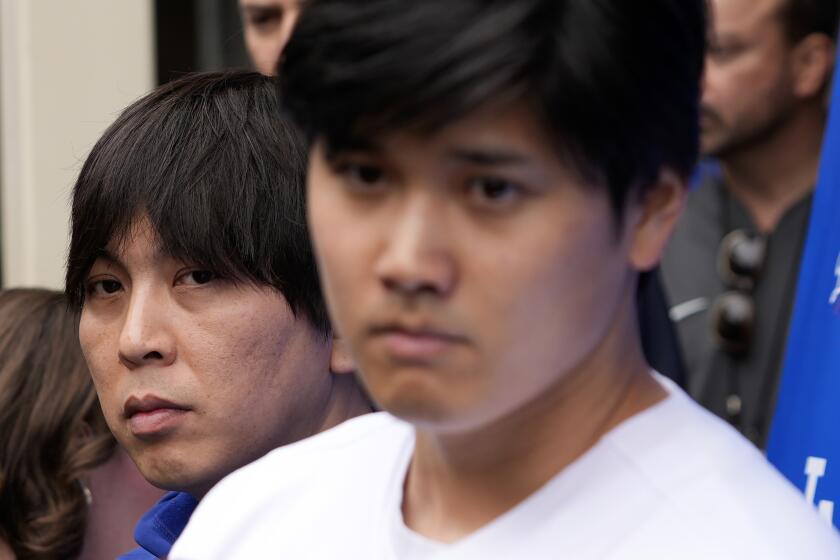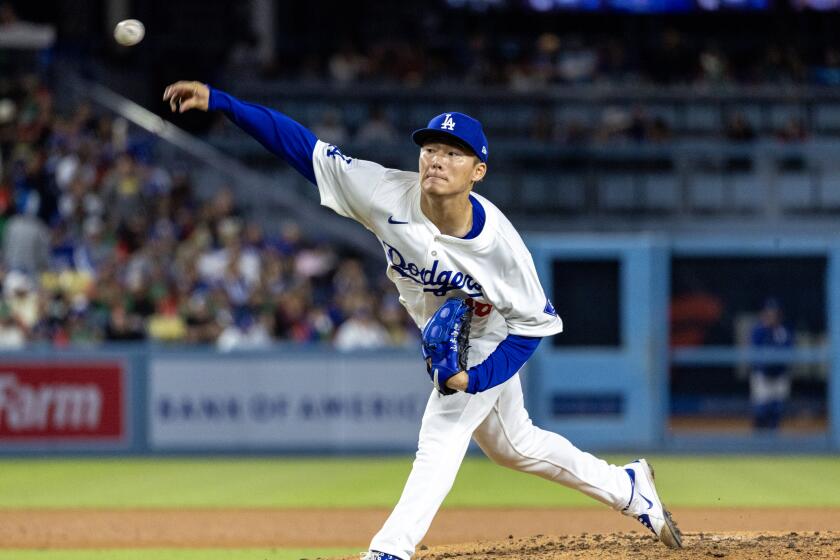The Patients of Jobe
“My first pitch to Breeden was. . . .strange. As I came forward and released the ball, I felt a kind of nothingness, as if my arm weren’t there, then I heard a ‘pop’ from inside my arm, and the ball just blooped up to the plate.” --From Tommy John’s autobiography, “My Twenty-six Years in Baseball.” In his 40-year run at Centinela Hospital Medical Center, Frank Jobe has mended the famous and anonymous without distinction, his elegant hand strokes in the operating room compared to those of a symphony conductor.
“Probably the most gifted natural surgeon I’ve ever seen,” son Christopher, also a surgeon, says.
Combining his skills with a love of sports, particularly baseball, Jobe has probably done more to fatten major league player wallets than anyone since union chief Marvin Miller.
Jobe’s revolutionary tendon transplant operation on Dodger pitcher Tommy John in 1974 remains the Mona Lisa of sports surgeries. Jobe added another brilliant brush stroke in 1989 with his landmark shoulder procedure on then-Dodger Orel Hershiser.
Hershiser, now a San Francisco Giant, returned to Los Angeles this summer to defeat his former team.
“I think what Dr. Jobe not only has done for me, but all of baseball--and baseball fans--is that he’s kept talent on the field, or put talent back on the field,” Hershiser says.
Although employed by the Dodgers, Jobe roots for rotator cuffs as much as does for the home team.
Nothing thrilled Jobe more than a July 20 pitching matchup at Dodger Stadium between Darren Dreifort and Cincinnati’s Steve Parris.
“I operated on both of them,” Jobe says. “That’s more important than who wins or loses to me.”
Jobe long ago stipulated he would never turn away anyone who needed his help, even if it meant costing the Dodgers the pennant.
“Just like in war,” Jobe says. “you take care of enemy soldiers that are hurt.”
Baseball’s infantry have been lining up at Jobe’s M*A*S*H tent for years. Robert Kerlan, Jobe’s longtime mentor and partner, died in 1996, but Jobe still stitches away steadily at age 73. He has reduced his work load of late, yet still operates three days a week.
He recently put Dodger pitcher Ramon Martinez’ shoulder back together. Jobe doesn’t get as nervous as he once did, waking in the pre-dawn hours before big operations, but the stakes are higher now than ever.
“If it’s successful,” Jobe says of Martinez’ surgery, “he’s probably going to make $5 million next year. If it’s not, he’s going to get bought out for $600,000. I try to put that out of my mind, of course.”
Jobe only beams when reviewing the chart of his life: His 39-year marriage to Beverly, the couple’s four successful sons, Frank’s fortunate making of Kerlan’s acquaintance.
Then there is Jobe’s Biomechanical Laboratory, his pride and joy, which he is presently trying to save from accountants’ scalpels.
Yet Jobe is perhaps most proud to have loyally carried the torch handed down from Hippocrates, the ancient Greek physician regarded as the father of medicine.
Hippocrates wasn’t just a doctor, Jobe says, but the first noted arm surgeon.
As Jobe hovered over Hershiser’s shoulder in surgery, he says he considered the lineage to Hippocrates, who thought highly of the shoulder’s importance.
“In war, a person who dislocates his shoulder is in serious trouble,” Jobe says. “If you’re fighting with a sword and the shoulder comes out of its socket, you’re dead.”
Luckily for Hershiser, Jobe opted for a procedure slightly more sophisticated than the one Hippocrates favored.
“He’d take the skin, pull it up and take a hot poker and put in the armpit and bind down the arm until it scarred and healed,” Jobe says of the Hippocrates’ technique. “The idea in those days was to keep the arm from coming out, they didn’t care about the range of motion.”
Hershiser, thank you, cared greatly about range of motion, so Jobe used a technique never before used on a pitcher. Instead of detaching the muscle in Hershiser’s shoulder to repair the joint, which would have jeopardized his flexibility, Jobe split the muscle and made the repair.
Not bad, eh Hippocrates?
Evolution of Surgery
“I lost complete use of my arm almost up to the elbow, leaving me with what they call a simian monkey hand. Monkeys don’t have an ulnar nerve and that’s why their hands and fingers curl. My hand looked like an ugly claw.”
--Tommy John
Long before Jobe stood over John in the operating room on Sept. 25, 1974, there would be career decisions.
Jobe grew up in North Carolina--the son of a farmer and postman--disinterested in medicine until enlisting with the Army’s 101st Airborne Division in 1943, where the 19-year-old became a medical supply sergeant.
He escaped World War II unscathed, notwithstanding a harrowing escape after Germans briefly captured him in Bastogne, Belgium. Jobe and a buddy hurled themselves down an embankment and eventually hitched a ride out of danger.
It was Jobe’s work with army doctors that kindled a spark for medicine. He returned home, attended junior college in Tennessee, then moved to Los Angeles to study at Loma Linda Medical School.
He worked three years as a family doctor to pay off school loans; his time spent in the emergency room steered him toward a career in orthopedics.
It was during his residency at Los Angeles County hospital that Jobe met Bob Kerlan, already an orthopedic specialist.
Kerlan suggested a partnership.
“We had no written contract, we had a handshake,” Jobe recalls.
After Jobe completed his residency, Kerlan was waiting.
Jobe began work at Centinela in June, 1958.
The Dodgers had moved west from Brooklyn the same year, and Kerlan was named team physician. Kerlan-Jobe would eventually enlist the Angels, Lakers and Kings as clients.
The Kerlan-Jobe Clinic, which would become world renown, opened in 1965.
“We really had a wonderful relationship for 35 years,” Jobe says of Kerlan. “It was almost like a marriage, we were very close. It was a matter of trust, I guess.”
Jobe scored his first surgery of note in 1964, removing bone chips from the elbow of Dodger pitcher Johnny Podres. Surgery was often seen as career ending then, yet Podres returned to pitch two more seasons.
In 1966, Sandy Koufax, the great Dodger left-hander, was forced to retire in his prime because of arthritis in his pitching elbow.
Not even Kerlan-Jobe could help.
“Sandy’s problem was mainly the articulating cartilage, he developed a change in the cartilage itself,” Jobe says. “We don’t even yet have a procedure to correct that. I’m not sure we could have done much for him even now.”
Human Guinea Pig
“Since no pitcher had ever had this kind of operation, no pitcher had ever come back from it. No one knew what to expect. We were making medical history.”
--Tommy John
As Jobe watched from his Dodger Stadium seat on July 17, 1974, John let go of the pitch to Montreal’s Hal Breeden.
John feebly attempted another throw before motioning Manager Walter Alston to the mound. Jobe headed to the locker room.
John would not throw another pitch in a big league game for 21 months.
Jobe feared the worst: torn ligaments. After eight weeks of rest, John still couldn’t pitch.
In John’s book, he says Jobe proposed the idea for a radical operation.
Jobe, ever self-effacing, credits John.
“Tommy sort of forced me into it,” Jobe says now. “Behind every good thing there is someone who puts the pressure on, I think.”
John says it was a no-brainer.
“I really didn’t have any options,” John says. “He said if I didn’t want to have it done, I could do other things in life, but I couldn’t play baseball. Well, I wanted to play baseball.”
John basically instructed Jobe to fix his elbow.
“What do you want to do?” Jobe recalls saying.
“Figure it out,” John replied.
Jobe figured it out. Tendon transplants had been used before with polio patients to reinforce joints, and also used in hand surgeries.
The procedure requires a six-inch long palmaris tendon to be removed from the non-injured arm, then woven and attached in place of the damaged ligament.
John’s ligament was torn in the middle, making reattachment impossible.
“I knew the tendon could be used,” Jobe recalls. “the only thing I didn’t know was whether it would stand up to throwing.”
John couldn’t wait to be a guinea pig.
Yet weeks after his four-hour surgery, John’s left arm dangled from his side, his fingers curled and deformed.
Another examination revealed John’s ulnar nerve had also been damaged.
In an procedure kept secret from the public, Jobe performed a second operation in December 1974 to repair the ulnar.
John says Jobe gave him a “one in one hundred” chance of pitching again.
“That was a wild guess,” Jobe says with a grin. “I didn’t have any idea what the chances were. I just said they weren’t very good.”
John returned to the mound in 1976 and pitched 14 more seasons.
His record before surgery was 124-106. His record after was 164-125.
John, now 55 and working for the New York Yankees’ minor league team in Charlotte, N.C., says he’s never had a sore arm since returning from the surgery.
“I throw batting practice every day,” John says. “One day, we had a media day, and I threw about 15 or 20 pitches to 80 or 90 people.”
Since 1974, Jobe has performed more than 500 “Tommy John” surgeries, mostly on pitchers, although Jobe has done the procedure on javelin throwers and tennis players.
Jobe has so perfected the operation he can now perform it in an hour.
“It’s probably the thing in my career that stands out,” Jobe says.
Jobe insists half the credit should go to John, whose diligence in rehabilitation made future operations possible.
“If I hadn’t had a patient who was intelligent, cooperative, and learned the principles of reconstruction, we might have failed and then never done it again,” Jobe says.
John says it was a partnership.
“He was a pioneer,” John says of Jobe. “But I consider him a friend as much or more as a surgeon. That’s very important. He’s really a kind-hearted person. I felt he wouldn’t tell me anything to do that wasn’t in my best interests. I think there are some doctors that will not tell you that.”
Rebuilt to Last
April 28, 1976. Dodgers 7, Pirates 1. Winning pitcher: Tommy John. It was his first victory since July 7, 1974.
“As I walked off the mound, I tipped my cap, then glanced over at (wife) Sally, who was on her feet, crying.”
No one knows how long Jobe can keep stitching together elbows and happy endings.
“Traditionally, in academic clinics, you gave up the academic approach at age 65, and put away the knife at 70,” Jobe’s son, Christopher, says. “But these are modern times, people live longer and stay competent longer.”
Frank Jobe tires more easily now but, as a surgeon, he remains a cut above.
“As long as your brain works right,” Jobe says, “you can go on indefinitely.”
So what about Jobe’s happy ending?
Given his body of work and contribution to baseball, one might think Jobe could dictate the terms of his legacy.
Yet, there are concerns.
Fox’s takeover of the Dodgers from the O’Malleys has left many in the organization uneasy.
Jobe recalls a medical dispute he had with a Dodger coach in the 1960s. Owner Walter O’Malley pulled Jobe aside and said, “Frank, we’ve hired you to be the doctor. You make the decisions. When we don’t like your decisions we’ll fire you.”
Oddly, the words were always comforting.
“Nobody’s ever questioned my decisions since then,” Jobe says. “I thought that was good backing.”
What now?
Jobe is in the first year of a three-year deal with the Dodgers.
“It is a concern,” he says of the ownership change. “I haven’t had any indication they’re going to fire me. I’ve had a longtime relationship with Tommy Lasorda. We’ve been pretty good friends. I don’t think Tommy will fire me, but you don’t know.”
Jobe also frets about the future of his biomechanical lab, which he opened at Centinela in 1979. It is there, Jobe says, that his best work has been done.
“If I’m remembered for anything, I’d rather be remembered for the exercises I’ve developed,” Jobe says.
Jobe’s lab researches how tendons and joints react under stress and then develops exercise programs for prevention and rehabilitation.
Until Martinez, the Dodgers had not had a rotator-cuff injury in five years.
But Centinela also has been taken over by new ownership, which is seeking ways to improve the bottom line.
Jobe’s son worries about his father’s legacy.
“Think about it,” Christopher says, “What do you have left after you die? Your children, and what you contributed to knowledge. That’s it. He’s contributed a lot of things. The public knows Tommy John and Orel Hershiser but his biomechanics lab probably publishes a half-dozen papers a year.”
In the end, Frank Jobe is hoping 40 years at Centinela counts for something.
“I know they’re looking at this lab, and saying, ‘Is it worth it?’ ” Jobe says. “Well, it’s worth it to me. I hope it’s worth it to them.”
More to Read
Are you a true-blue fan?
Get our Dodgers Dugout newsletter for insights, news and much more.
You may occasionally receive promotional content from the Los Angeles Times.







